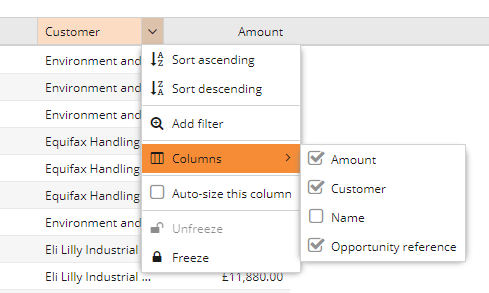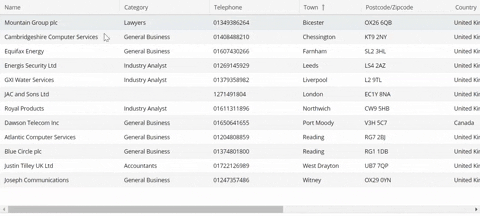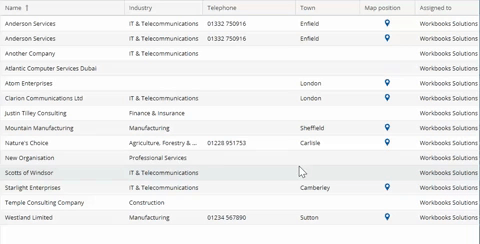- Welcome to the Knowledge Base
- Introduction
- Training
- Getting Started
- Preferences
- Activities
- Cases
- Forecasts & Quotas
- Importing Data
- Leads
-
Marketing
- Introduction to Marketing
- Marketing Campaigns
- Mailing Lists
- Products
- Mailshots
- Upload Library
- Templates
- Event Management
- Compliance Records
-
Spotler Integration
- What is Spotler?
- Navigating your Spotler homepage
- GatorMail
-
GatorLeads / Web Insights
- Tracking Code
- Setting up the Plugin
- Viewing Web Insights Data on your Form Layouts
- Domain Names and Online Activities
- Reporting incorrect Leads created through Web Insights
- Reporting on Web Insights data
- Using UTM Values
- Why aren’t Online Activities being created in the database?
- Why is GatorLeads recording online activities in a foreign language?
- GatorSurvey
- GatorWorkflow
- GatorPopup
- Opportunities
-
Integrations
- Mapping
- Electronic Signing Tools
- Creditsafe Integration
-
Zapier
- Introduction to Zapier
- Available Triggers and Actions
- Linking your Workbooks Account to Zapier
-
Setting up Zaps
- Posted Invoices to Xero Invoices
- Xero payments to Workbooks Tasks
- New Case to Google Drive folder
- New Case to Basecamp Project
- New Workbooks Case to JIRA Ticket
- Jira Issue to new Case
- 123FormBuilder Form Entry to Case
- Eventbrite Attendee to Sales Lead and Task
- Facebook Ad Leads to Sales Leads
- Wufoo Form Entry to Sales Lead
- Posted Credit Note to Task
- QuickBooks Online
- Survey Monkey responses to Tasks
- Multistep Zaps
-
Email Integrations
- Email Dropbox
- Workbooks Exchange Server Sync
- Workbooks Outlook Connector
- RevenueGrid Intelligence and Engage
-
Event & Webinar Integration Tools
- GoToWebinar
- ON24
- Microsoft Office
-
Outreach
- Installation
- Outreach Authentication
- Sync People to Outreach Prospects
- Sync Organisations to Outreach Accounts
- Sync Workbooks Opportunities to Outreach
- Sync Tasks/Activities from Workbooks to Outreach
- Sync Outreach Sequences to Workbooks
- Sync Outreach Sequence States to Workbooks
- Sync Outreach Sequence Step Numbers to Workbooks
- Sync Prospects/Accounts/Opportunities from Outreach to Workbooks
- Sync Outreach Tasks/Calls/Meetings to Workbooks
- Scribe/Workbooks Connector
- RingCentral
- Auditing
- Comments
- People & Organisations
- Projects
-
Reporting
- Introduction to Reporting
- Using Reports
- Charts
- Exporting Reports
- Advanced Reporting
- Report Snapshots
- Dashboards
-
Transaction Documents
-
Introduction to Transaction Documents
- Displaying & Adding Transaction Documents
- Copying Transaction Documents
- Transaction Documents Fields Help
- Transaction Documents Line Items Help
- Printing & Sending Transaction Documents
- Managing Transaction Document Currencies
- Managing Transaction Document Statuses
- Setting a Blank Default Currency on Transaction Documents
- Credit Notes
- Customer Orders
- Invoices
- Quotations
- Supplier Orders
- Contract Management
- Sagelink
-
Introduction to Transaction Documents
- Auditing
-
Configuration
- Introduction to System Administration
- Users & Security
- Preferences
- Database
- Accounting
- Email & Integration
-
Customisation
- Creating & Modifying Picklists
- Theme
-
Record Types
- Creating Custom Fields
- Report-based Custom Fields
- Linked Fields & Reference Fields
- Record Templates
- Form Layouts
- Customising relationships between parties
- Opportunity Stages
- Custom Records
- Automation
- PDF Configuration
- Contact Support
- Releases & Roadmap
Customising Columns
Tip
Remember to click View > Save or Save As to retain any customisation you've applied.
Adding/Removing Columns
To add a new column to the data displayed, hover over the right-hand side of the header row of one of the columns until you see a down arrow. Click on the arrow and from the menu that appears, choose Columns. A sub-menu will appear listing all the fields it's possible to display for this area of the database. Put a tick in the relevant box(es) for any columns you want to display and remove the tick for any you don't want to see, as shown below:

Rearranging Columns
To change the order of the columns displayed click on the header row of the column you want to move and, with the left mouse button held down, drag it to the boundary between the two columns where you want it to appear. When it's where you want it to be, release the left mouse button to drop the column into place. The image below shows the Industry column being moved so that it appears next to the Name column instead of the Town column:

Resizing Columns
To resize a column click on the boundary line on the right-hand side of the header row and drag it to your desired width. All columns can be resized automatically using the View > Autosize all columns checkbox. If this check box is ticked, you will be unable to adjust the individual columns.
Sorting Columns
There are three ways to sort columns in grid views:
1. Click on the column header, which will sort the column in ascending order. Clicking the column header again will then sort it in descending order.
2. Click on the down arrow and choose if you want it in ascending or descending order.

3. Click View > Sort and click on either the ascending or descending option next to the field you want to sort by. This makes it easy to sort by a column that isn't showing in your view.

Freezing Columns
You can freeze columns to make it easier to review data when scrolling across pages with many columns. To do this click on the down arrow on the column you want to freeze, and click the Freeze option. Repeat this on any additional columns you want to freeze, or drag and drop them into the frozen section. Click on the down arrow and choose Unfreeze to put them back to normal.

Grouping Columns
It can be useful to group similar types of data together for ease of navigation. To do this hover over the header row of the column you want to group by until you see a down arrow. Click on the arrow and from the menu that appears, choose Group By This Field. Workbooks will automatically group the data in the column for you. Below shows the Organisation Landing Page being grouped by Industry.

To remove grouping, click on the header row of any of the columns and remove the tick from the Show in Groups box.
Related content

